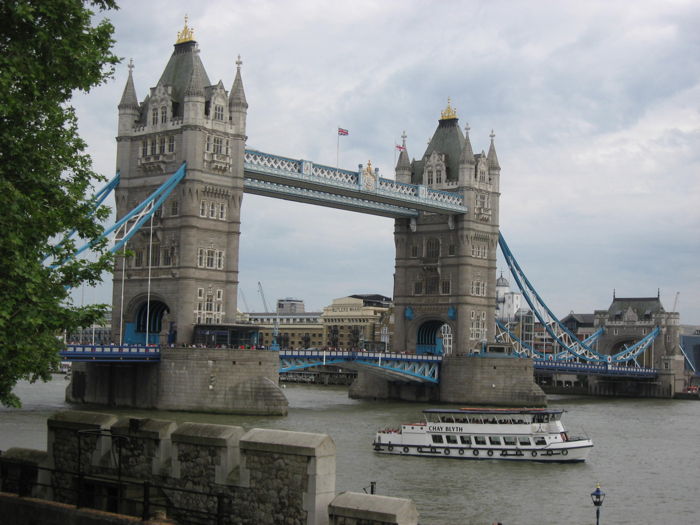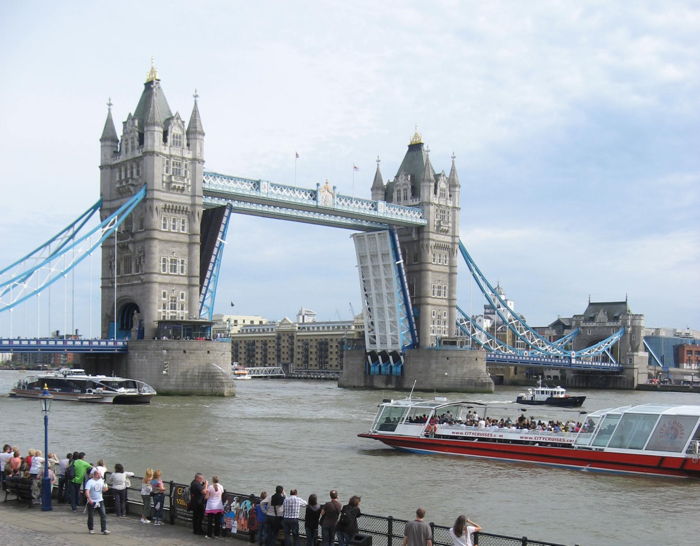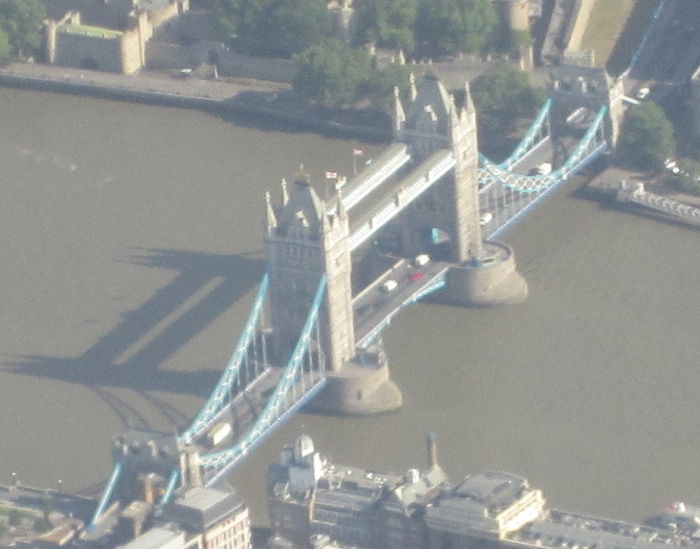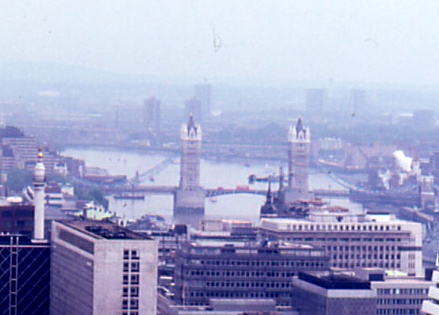Tower Bridge
|
Tower Bridge Tower Bridge is a combined bascule and suspension bridge in London, England, over the River Thames. It is close to the Tower of London, which gives it its name. It has become an iconic symbol of London. The bridge consists of two towers which are tied together at the upper level by means of two horizontal walkways which are designed to withstand the horizontal forces exerted by the suspended sections of the bridge on the landward sides of the towers. The vertical component of the forces in the suspended sections and the vertical reactions of the two walkways are carried by the two robust towers. The bascule pivots and operating machinery are housed in the base of each tower. The bridge's present colour dates from 1977 when it was painted red, white and blue for the Queen's Silver Jubilee. Originally it was painted a chocolate brown colour. Originally, Tower Bridge was a hydraulically operated bridge, using steam power from coal-burning boilers to pump river water into six hydraulic accumulators so that power was readily available when required. The water for the boilers was provided by a well. The hydraulic accumulators powered the bascule engines, which raised and lowered the bascules. Today, the bascule mechanism is driven by oil and electricity rather than by water and steam. Construction started in 1886 and took eight years with five major contractors – Sir John Jackson (foundations), Baron Armstrong (hydraulics), William Webster, Sir H.H. Bartlett, and Sir William Arrol & Co. – and employed 432 construction workers. E W Crutwell was the resident engineer for the construction. Two massive piers, containing over 70,000 tons of concrete, were sunk into the riverbed to support the construction. Over 11,000 tons of steel provided the framework for the towers and walkways. This was then clad in Cornish granite and Portland stone, both to protect the underlying steelwork and to give the bridge a pleasing appearance. Jones died in 1887 and George D. Stevenson took over the project. Stevenson replaced Jones's original brick façade with the more ornate Victorian Gothic style, which makes the bridge a distinctive landmark, and was intended to harmonise the bridge with the nearby Tower of London. The total cost of construction was £1.2 million (£100 million as of 2011). Photo 552, May 2011 |

|
|
Tower Bridge in the raised position. (continued)Construction started in 1886 and took eight years with five major contractors – Sir John Jackson (foundations), Baron Armstrong (hydraulics), William Webster, Sir H.H. Bartlett, and Sir William Arrol & Co. – and employed 432 construction workers. E W Crutwell was the resident engineer for the construction. Two massive piers, containing over 70,000 tons of concrete, were sunk into the riverbed to support the construction. Over 11,000 tons of steel provided the framework for the towers and walkways. This was then clad in Cornish granite and Portland stone, both to protect the underlying steelwork and to give the bridge a pleasing appearance. Jones died in 1887 and George D. Stevenson took over the project. Stevenson replaced Jones's original brick façade with the more ornate Victorian Gothic style, which makes the bridge a distinctive landmark, and was intended to harmonise the bridge with the nearby Tower of London. The total cost of construction was £1.2 million (£100 million as of 2011). Photo 545, May 2011 |

|
|
Tower Bridge of London. Photo 20d2, May 2011 |

|
|
Tower Bridge, London, 1979 Tower Bridge is a combined bascule and suspension bridge in London, England, over the River Thames. It is close to the Tower of London, which gives it its name. It has become an iconic symbol of London. The bridge consists of two towers which are tied together at the upper level by means of two horizontal walkways which are designed to withstand the horizontal forces exerted by the suspended sections of the bridge on the landward sides of the towers. The vertical component of the forces in the suspended sections and the vertical reactions of the two walkways are carried by the two robust towers. The bascule pivots and operating machinery are housed in the base of each tower. The bridge's present colour dates from 1977 when it was painted red, white and blue for the Queen's Silver Jubilee. Originally it was painted a chocolate brown colour. Tower Bridge is sometimes mistakenly referred to as London Bridge, which is actually the next bridge upstream. Photo 148d, 1979 |

|